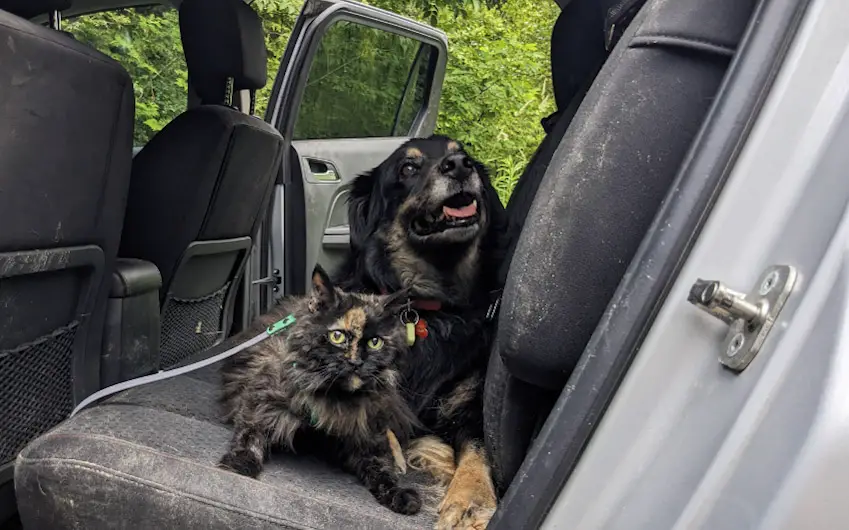5 Tips For A Successful Road Trip With Dogs Or Cats

Heading out on a road trip to check out the beautiful destinations here in Ontario is an exciting experience, but that becomes even more memorable when you can share that journey with your best furry friend.
Over the last 20+ years, we have had the opportunity to take countless road trips and adventures with our pets. More recently, this includes packing up our vehicle to explore the province with three dogs and two cats in an SUV. If that sounds like a challenging experience, it definitely can be! But we have had the opportunity to pick up some game-changing tips and tricks to enjoy a road trip with dogs or cats – and we want to share them with you!
So, buckle up and get ready to head out on the road for an adventure like no other with the world’s best travel companion by your side.

Is It Safe To Take A Dog On A Road Trip?
Yes! Many great advances in pet care products have made it easier than ever to enjoy a safe and enjoyable road trip for you and your dog.
The most important thing to consider when planning your next road trip is how you will secure your dog in the vehicle. For smaller dogs, this could be as simple as keeping your dog in its carrier and using your vehicle seat belts to prevent the carrier from being thrown around during an accident.
For larger dogs, dog-friendly seatbelts have been developed to be used with a harness. Your dog’s harness should be padded, especially across the chest area, to avoid injuries in a sudden stop.
There are different styles of dog seatbelts to choose from, including:
- Basic Seat Belt Tethers: These short tethers fasten into the belt buckle on one end. The other end features a clasp or carabiner that can be attached to your dog’s harness. They may be a solid material or, as an added safety measure, including an anti-shock bungee buffer.
- Headrest Dog Restraints: Like the basic seat belt tethers, this style attaches with a clip or carabiner to your dog’s harness. However, they are secured in the vehicle differently. The other end is a loop designed to be secured around the base of your vehicle’s headrest.
- Dog Zipline: Designed to give your dog more room to move in the vehicle, the zipline-style seatbelt features a band that connects to two fixed points, like your ceiling handles or the existing seat belts on each side of a bench seat. A tether is attached to this zipline, which can slide back and forth as your dog moves while keeping them secured.
- Car Seat Tether: These seatbelts affix to the same points on the seat that a child’s seatbelt wood, with connection points at the top and bottom of the seat for extra security.
- Seat Belt-Compatible Harnesses: Rather than introducing any type of additional seat belt to the mix, these harnesses are designed to work directly with the existing seat belts in your vehicle. They feature a loop on the back of the harness large enough that your vehicle seat belt can be fed through to hold your dog safely in place.
Just as you must buckle your seat belt whenever the vehicle is in motion, the same rule can be applied to your dog. A free-roaming dog is at risk during an accident and can also present a safety risk as a distraction moving about your vehicle while you are focused on driving.

Can You Enjoy A Long Car Ride With A Cat?
While a road trip with a dog isn’t uncommon, we don’t hear as much about travelling with cats in the car for a long distance. Is it even possible to enjoy a road trip with a cat?
The answer is a resounding yes!
In recent years, there has been a growing interest in including cats in our travel plans. The term “Adventure Cats” has caught on as cats can be seen camping, hiking, canoeing, and road-tripping with their families.
Many important considerations for a pet-friendly road trip will be the same, regardless of whether your furry passenger is a cat or a dog. For example, your cat should be safely secured in their carrier when the vehicle is in motion. But there are a few added points to consider. The most significant difference when travelling with a cat is their need for a litter box.
Like you, your cat will need “bathroom breaks” where the litter box is made accessible to them. How often this is will depend on your cat’s age, health, and daily habits.
If you’re concerned about the smells often associated with your cat’s bathroom space, you may consider purchasing a travel litter box. These usually offer a lid that can be fastened or zipped up to help contain unpleasant smells while preventing spills.

Do Pets Get Stressed On Road Trips?
For some pets, a road trip can be a very stressful and anxiety-ridden experience, especially if this is their first time in the vehicle for an extended period. Pack some calming treats before heading out if your dog or cat is nervous or unsure about the vehicle. These treats include vitamins or herbs that provide a natural calming effect, helping your pet settle during their travels.
If you have tried travelling with your pet and found the calming treats aren’t enough, you can talk to your veterinarian about options for anxiety medication. But at that point, you should also take a step back and consider whether bringing your cat or dog on the road is the best idea. If they aren’t comfortable or enjoying the experience, they may be happier staying home with a friend or family member.
5 Tips For A Safe And Enjoyable Road Trip With Your Dog or Cat
Are you gearing up for your first road trip with dogs or cats but worried about whether you are fully prepared for the experience? Here are a few tips and tricks we’ve picked up while road-tripping with our 5 pets regularly.
Ensure Your Pet Has Proper ID
You can take all the safety precautions possible, and accidents still happen. For this reason, we need to be prepared for the possibility that your pet may get loose at some point in your travels. Ensure all pets wear a collar with an ID tag containing your current contact information. If your pet is microchipped, double-check that all the information on their file is accurate and current.
Pack a Pet-Focused First Aid Kit
While a human first aid kit will provide most of the essential supplies for an emergency, a pet-focused first aid kit includes some added products with your furry friend’s needs in mind. This includes vet-wrap bandages that help to keep wound dressings in place and styptic powder to stop bleeding quickly and effectively from a broken nail.
Create a “Safe Space” in Your Vehicle
When setting up your pet in the vehicle, you must create a space where they feel secure and comfortable. The best option for nervous pets is to create a space separate from any other high-energy pets or children.
Consider including your pet’s blanket from home and a couple of their favourite toys. These items will carry a familiar scent that can help to calm them in new environments. These items can also be brought into a hotel room or overnight rental on weekend trips to help them better adjust to their new surroundings.
Make Time for Breaks as Needed
The number of breaks needed will vary from pet to pet. Young puppies, kittens, and senior pets will need bathroom breaks more frequently to avoid vehicle accidents. But avoid taking breaks too often and disturbing your pet unnecessarily if they have settled into that comfortable space you created. The best plan is to be flexible and watch your pet’s body language to determine when to pull into a rest stop.
Prioritize Proper Hydration
Pack plenty of fresh water with dogs or cats on a road trip. Offer a chance for your pet to drink at each break. Pets that are nervous, anxious, or overly excited may pant more than usual. This causes them to lose water faster, meaning they must drink more to replace those fluids.
You can also offer canned foods with high water content or lickable dog and cat treats to provide water in other forms. Spread these items on a lick mat for mental enrichment and calming properties. The licking has been proven to be self-soothing and can make their trip much more enjoyable if they struggle with nervousness.

Final Thoughts: Planning a Successful Road Trip with Dogs and Cats
There are so many exciting places to explore here in Ontario, and as a pet owner, you may want to do that exploring with your best friend by your side. Whether you’re planning a quick day trip to check out the attractions in your own backyard or heading out on a weekend getaway, your pet can be part of the plan. But it will take a little extra planning and preparation.
Create a packing list for your pet’s supplies, paying careful attention to their safety needs like seatbelts or carriers and a pet-focused first aid kit. Set up your car to give them space to relax with plenty of airflow. Include some comfort items from the home to help them settle in and enjoy the experience, even if they are initially a little nervous.








4 Comments